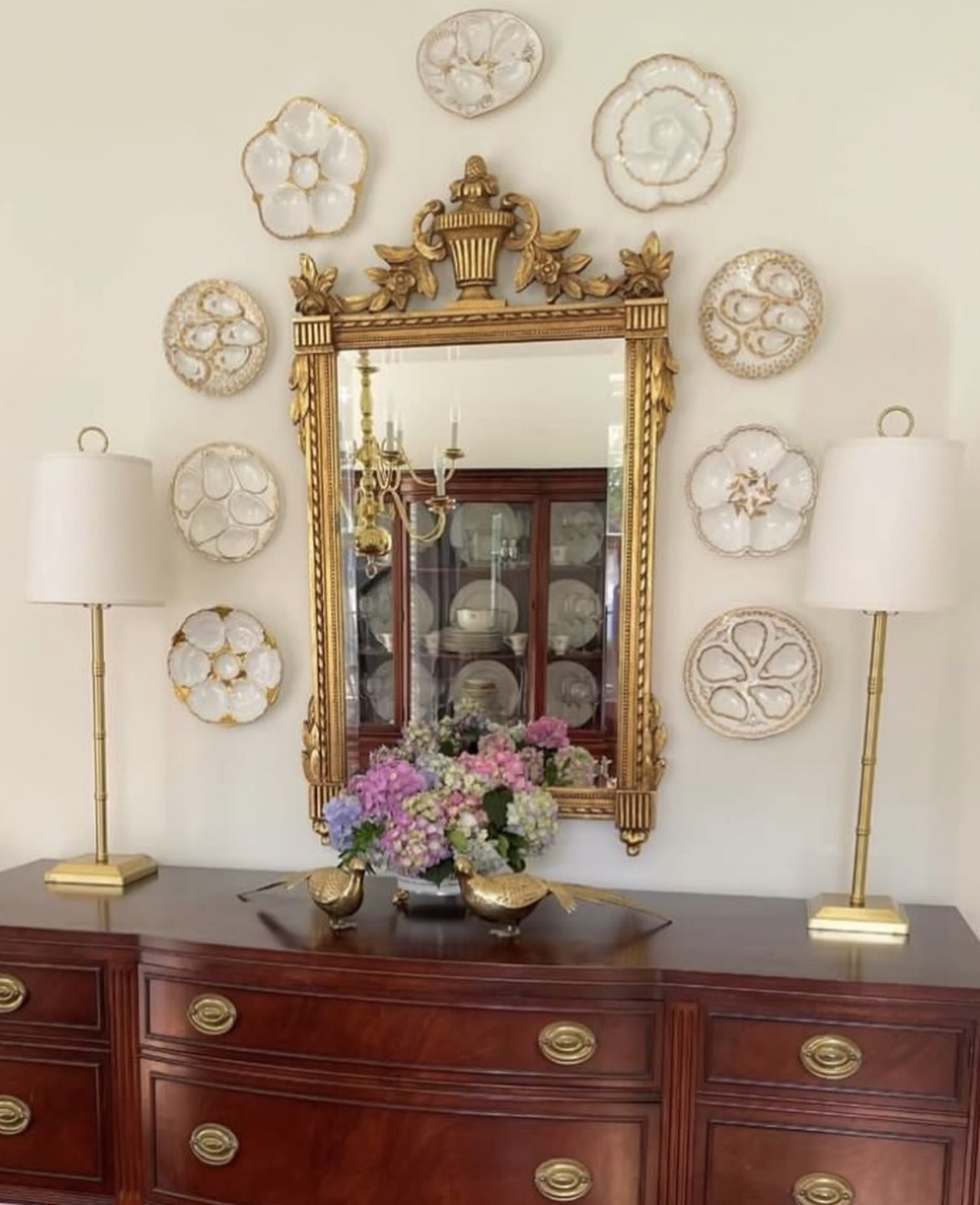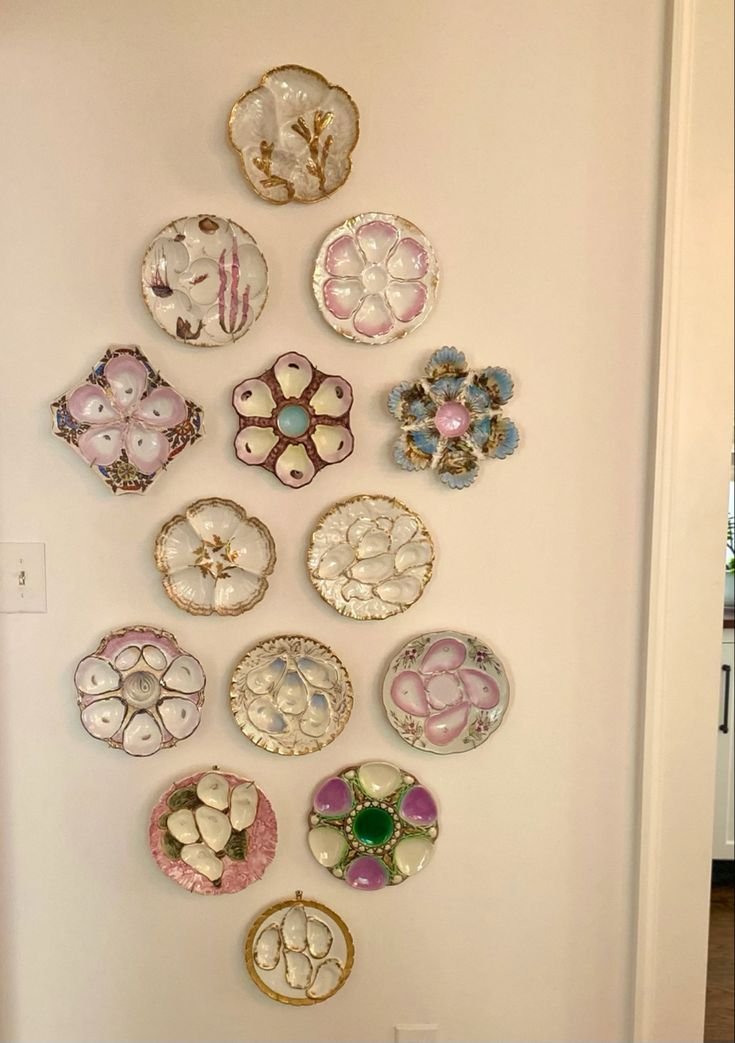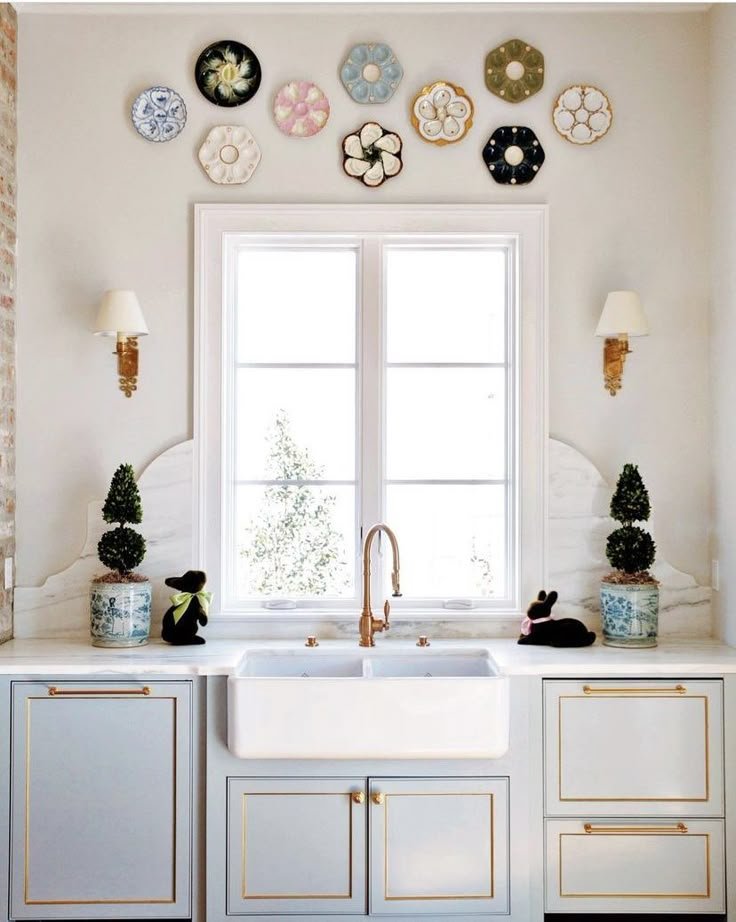As most of you know, I’ve been a long time lover or second hand shopping for the home and curating antiques. I’ve been shopping more than ever this year.
There’s something unexpectedly elegant and intriguing happening in the world of vintage design that I’ve noticed—oyster plates are back.
Once a staple of 19th-century dining culture, these intricately detailed dishes have found new life as coveted collectibles and statement pieces in modern decor.
Mally Skok via Luxe photography by Sarah Winchester
Whether mounted on a gallery wall or styled in a cabinet of curiosities, oyster plates bring both history and high style to any space.
If you're unfamiliar with these charming collectibles—or you're already hunting for your next find—this post will walk you through everything you need to know about oyster plates: their history, their value, and how to use them in today's chic interiors.
Related Reading: How to curate a thrifted / antique gallery art wall
Stunning pink & pretty arched oyster plate wall - @valleyvintageva
What Is an Oyster Plate?
An oyster plate is a specialized dish designed to serve oysters on the half shell. Typically featuring 5 to 6 individual wells in a circular pattern to hold the oysters, and often a central well for sauce or lemon, these plates were once considered the height of refinement. Most were made from porcelain or ceramic, and many boasted gilded edges, hand-painted motifs, floral or ocean-themed designs, and sometimes even molded shell-like shapes.
White and gold oyster plate wall - Sterling Oyster
A Brief History of the Oyster Plate
Oyster plates rose to popularity in Victorian-era Europe and America during the mid-to-late 1800s when oysters were a culinary delicacy enjoyed at fashionable gatherings. At that time, dining was both performance and ritual. The presentation of food was just as important as taste, which led to the creation of ornate tableware like the oyster plate.
French and German manufacturers such as Limoges, Haviland, Meissen, and Royal Worcester were known for producing the most elaborate and luxurious versions.
In the United States, oyster plates were made by companies like Wheeling Pottery, Chesapeake Pottery, and Union Porcelain Works of New York, reflecting the nation’s own oyster craze.
Many antique oyster plates feature the Aesthetic Movement style, a design trend that celebrated nature, art, and beauty for beauty’s sake.
As oyster consumption declined in the early 20th century—partially due to overfishing and changing culinary trends—so did the production of oyster plates.
Gorgeous + Green Dining room oyster plate wall - Ballard Design
Why Oyster Plates Are Coveted Antiques Today
Today, oyster plates are considered highly collectible, especially those from the 19th century. Their value can range from $50 to over $1,000 depending on condition, rarity, and maker.
Collectors are drawn to them because:
They represent a specific time in culinary and design history.
Their colors and craftsmanship are often unmatched by today’s mass-produced dishware.
They come in a wide variety of designs—from pastel florals to bold geometric arrangements—making them perfect for visual storytelling.
They're functional art—as striking on a wall as they are on a table.
Pastel oyster plate wall - @papierfleurs
If you're new to collecting, look for:
Marks or stamps indicating maker and origin.
Hand-painted detail, not decals.
Plates in excellent condition (no chips, crazing, or fading).
Designs with irregular or asymmetrical wells—these tend to be rarer.
The Rise of the Oyster Plate in Modern Design
So why the sudden resurgence?
Designers and decorators are increasingly leaning into eclectic, vintage, and historically layered interiors. In a world filled with minimalism and neutrals, oyster plates offer personality, color, and patina. They fit beautifully into:
Grandmillennial and cottagecore aesthetics
European-inspired kitchens and dining rooms
Eclectic gallery walls and curated plate displays
Modern coastal or Southern traditional homes
They also offer an unexpected take on “art”. Hanging a collection of oyster plates—mismatched or matched—adds instant depth and conversation to a room.
Styling Oyster Plates in Your Home
Here are a few ways to make oyster plates shine in your space:
Create a plate wall: Mix sizes, colors, and shapes for a gallery effect. Use plate hangers or invisible disc adhesives.
Incorporate into a tablescape: Add vintage charm to your next dinner party by mixing antique oyster plates with modern pieces.
Layer in a cabinet or hutch: They make beautiful backdrops behind glass.
Use a single plate as art: Let one rare beauty speak for itself on a small wall or in a powder room.
Oyster plate wall collections I love:
Credit: Hayden Moss
Why Antique Plate Walls Are Incredibly Chic
There’s a reason antique plate walls have made a major comeback in the design world—they’re visually stunning, deeply personal, and full of character. A well-curated plate wall tells a story, adds depth to your space, and allows you to showcase your unique taste in a way that's both refined and whimsical. Unlike mass-produced wall art, plate walls are curated and collected over time, giving them that lived-in, layered European feel that interior designers love. And if you’re looking to take your plate wall to the next level? Oyster plates are an absolute must. Their intricate shapes, delicate wells, and often iridescent or hand-painted finishes make them standout stars within a plate collection. They offer texture, color, and historical flair that few other collectibles can match. Including oyster plates in your display instantly elevates it from “pretty” to showstoppingly chic.
Oyster Plate FAQs
What makes an oyster plate valuable?
Several factors determine an oyster plate’s value: age, maker, condition, rarity, and design. Plates from well-known manufacturers like Haviland Limoges, Minton, or Union Porcelain Works are especially desirable. Hand-painted details, unusual color palettes, and unique shapes also increase value. Plates in excellent condition with no chips, cracks, or crazing will always fetch higher prices.
Can you eat off of antique oyster plates today?
While you can technically eat off many antique oyster plates—especially if they’re in excellent condition and lead-free—most collectors prefer to use them for display purposes only. If you plan to serve food on them, make sure they're free from cracks and verify the materials are food-safe.
How do you hang oyster plates on a wall?
You can use invisible plate hanging discs, wire plate hangers, or plate shelves to display them. Just be sure to choose hanging methods that won’t damage the plate and always anchor your hardware securely to the wall to support the weight.
Where should I look for authentic vintage or antique oyster plates?
Top places to shop include Etsy, eBay, Chairish, 1stDibs, local antique stores, estate sales, and even vintage Instagram sellers. Always check for backstamps or markings that can identify the origin and maker.
A few oyster plates I would consider:
Antique France fives Lily Oyster plate | French Blue Majolica oyster plate |
Vintage emerald Green Majolica | French peach & blue oyster plate |
2 Pastel pink & blue oyster plates | Pink French Limoges Oyster plate
Gold & White French Limoges Oyster plate
How do I care for and clean antique oyster plates?
Handle with care and wash by hand only using mild soap and lukewarm water. Avoid the dishwasher, as heat and strong detergents can cause crazing or wear away delicate finishes and gilding.
Are oyster plates always round?
Most are round or oval, but some rare and highly collectible oyster plates come in shell-shaped, asymmetrical, or even fan-like designs. These unique shapes are often the most eye-catching in plate walls and typically more valuable.
What other types of plates pair well with oyster plates in a wall display?
Mixing oyster plates with transferware, flow blue, Majolica, or hand-painted porcelain plates creates a rich and layered look. Stick to a color palette or style (like floral, nautical, or French country) for cohesion, or go eclectic for an artsy, collected-over-time feel.
























































